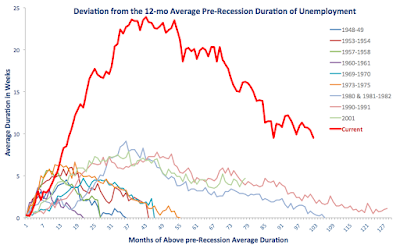Continuing with the coverage of Q4 2013 QNHS results for Ireland:
- First post covering detailed analysis of employment by sectors:
http://trueeconomics.blogspot.ie/2014/02/2722014-employment-by-sectors-qnhs-q4.html
- Second post covering employment across broader sectors and categories:
http://trueeconomics.blogspot.ie/2014/02/2822014-new-employment-across-broader.html
- Third post covering Participation and Unemployment Rates:
http://trueeconomics.blogspot.ie/2014/02/2822014-participation-and-unemployment.html
In the current post let us consider changes in duration of unemployment.
The CSO reports two basic duration metrics:
- Less than 1 year,
- 1 year and over
And the data covers different age groups:
- All population 15 years and older
- Population 15-24 years of age,
- Population 25-44 years of age, and
- Population 45 years of age and older.
Here are the charts and quick commentary on these. The data is not seasonally-adjusted, so there is a lot of volatility and I am not going to do q/q analysis here.
For overall population 15 years of age and over:
- Q4 2013 total unemployment declined 14.05% (41,400 in level terms) compared to Q4 2012. In 2012, Q4 y/y decline was -6.1% (-19,300 in level terms). Thus, 2013 numbers are much better compered to 2012 numbers, as one should expect.
- Of these, unemployment numbers for duration less than 1 year have declined 18% (-20,900) in Q4 2013. Te good news - this reversed 2012 y/y rise of 2.0% (+2,300).
- Unemployment with duration over 1 year has fallen as well, in Q4 2013 this was down 11.8% (-20,900) compared to Q4 2012, which is a small gain on decline recorded in Q4 2012 (y/y -10% and -19,700).
So good news here is that numbers are declining for both long-term and short-term unemployed. However, while overall unemployment numbers have now fallen to the levels below those recorded in Q4 2009 (though ahead of those in Q4 2008), long-term unemployed numbers are down to the levels below those recorded in Q4 2010 and are way ahead of those in Q4 2009.
Since the current Government came to power (H1 2011), unemployed numbers for those over the age 15 are down 59,300, of which 36,050 declines came from the ranks of short-term unemployed and 22,050 declines came from the ranks of long-term unemployed.
Given the difficulty of reducing long-term unemployment compared to short-term unemployment, this is still a good record.
However, given that we do not know how many of long-term unemployed are gaining jobs vs how many are dropping out of the labour force (emigration or exits from workforce) we really have little to go in identifying how god the above aggregates really are.
Charts below plot unemployment by duration for different age groups.
Youth unemployment (15-24 years of age) is shrinking. Across total youth unemployment, in Q4 2013 numbers unemployed fell 17.3% y/y (down 10,200 in level terms), building on 12.9% (-8,700) decline in Q4 2012.
Compared to H1 2011, youth unemployment is down 19,950 (-29%) overall, with 11,000 of this decline coming from short-term unemployed figures and 8,450 from long-term unemployed ranks.
The problem with the above numbers is that we do not know the sources for these declines in youth unemployment. These, in addition to people gaining jobs, include demographic transition (entry of new young workers and exists of previously younger workers into the next category of 25-44 year olds), exits to and entries from education and training, including State Training programmes, emigration, including short-term migration on post-education visas and so on).
The weakest performance by age group is in the 45 and over category. Here, in Q4 2013 the numbers unemployed declined only 8.6% y/y (down 6,900 in level terms). The good news is that this reversed the rise in unemployment in this category recorded in 12 months through Q4 2012 (+3.0% and +2,300). Compared to H1 2011, numbers unemployed in this age group are still higher (+2.8% and +2,000). Numbers of long-term unemployed dipped in Q4 2013 only slightly (by 6.7% or -3,700) and compared to H1 2011 long-term unemployment in this age category is still up +11.4% or +5,250.
So overall, these are pretty solid numbers,with core reading showing that total number of unemployed for age 15 and over is currently at the lowest level for any Q4 period since (and including) Q4 2009.
Lastly, on severity of long-term unemployment, consider the chart plotting percentage of long-term unemployed in each age group total unemployment numbers:
This clearly shows that since around H2 2012, the positive trends in overall unemployment are broadly translating into symmetric reductions in unemployment for both short-term and long-term unemployed for all age groups. Again, this is a positive trend in the short run, as long-term unemployment is the hardest (or the stickiest) of all forms of unemployment and we can expect an upward trend in these charts. This was indeed the case in the period prior to H2 2012. Since then, however, we are seeing reductions in unemployment of relatively similar proportions for short-term and long-term unemployed.





























